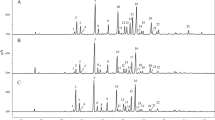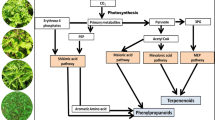Abstract
The rhizome and leaf essential oil compositions of Acorus calamus L. (Araceae) have been investigated in detail from various parts of the world, but the root oil composition has rarely been investigated. In present study, the root essential oil composition of A. calamus was investigated using gas chromatography (GC) and GC–mass spectrometry. A total of 21 constituents, forming 76.6 % of the total oil composition were identified. Major constituents of the oil were β-gurjunene (28.0 %), (Z)-asarone (13.7 %), aristolene (13.4 %), and (E)-asarone (7.9 %). The root oil composition was quite different from rhizome and leaf oil compositions of A. calamus.


Similar content being viewed by others
References
Wilczewska AZ, Ulman M, Chilmonczyk Z, Maj J, Koprowicz T, Tomczyk M, Tomczykowa M (2008) Comparison of volatile constituents of Acorus calamus and Asarum europaeum obtained by different techniques. J Essent Oil Res 20(5):390–395
Motley TJ (1994) The ethnobotany of sweet flag, Acorus calamus (Araceae). Econ Bot 48(4):397–412
Khare CP (2007) Indian medicinal plants: an illustrated dictionary. Springer, Berlin
Madan BR, Arora RB, Kapila K (1960) Anticonvulsant, antiveratrinic and antiarrhythmic actions of Acorus calamus Linn. an Indian indigenous drug. Arch Int Pharmacodyn Ther 124:201–211
Sharma JD, Dandiya PC (1962) Studies on Acorus calamus. VI. Pharmacological actions of asarone and beta-asarone on cardiovascular system and smooth muscles. Indian J Med Res 50:61–65
Kumar R, Prakash O, Pant AK, Hore SK, Chanotiya CS, Mathela CS (2009) Compositional variations and anthelmentic activity of essential oils from rhizomes of different wild populations of Acorus calamus L. and its major component, β-asarone. Nat Prod Commun 4:275–278
Tripathi AK, Singh RH (1995) Clinical study on an indigenous drug vacha (Acorus calamus) in the treatment of depressive illness. J Res Ayurveda Siddha 16:24
Senthilkumar A, Venkatesalu V (2012) Larvicidal potential of Acorus calamus L. essential oil against filarial vector mosquito Culex quinquefasciatus (Diptera: Culicidae). Asian Pac J Trop Dis 2(4):324–326
Ghosh M (2006) Antifungal properties of haem peroxidase from Acorus calamus. Ann Bot 98:1145–1153
Lee JY, Lee JY, Yun BS, Hwang BK (2004) Antifungal activity of β-asarone from rhizomes of Acorus gramineus. J Agric Food Chem 52:776–780
Jain N, Jain R, Jain A, Jain DK, Chandel HS (2010) Evaluation of wound-healing activity of Acorus calamus Linn. Nat Prod Res 24(6):534–541
Goeggelmann W, Schimmer O (1983) Mutagenicity testing of β-asarone and commercial calamus drugs with Salmonella typhimurium. Mutat Res 121:191–194
Anonymous (1981) Flavouring substances and natural sources of flavourings. Council of Europe, Maisonneuve, Moulins-Les-Metz, 3rd edn, Appendix A, p 34
Bisht D, Pal A, Chanotiya CS, Mishra D, Pandey KN (2011) Terpenoid composition and antifungal activity of three commercially important essential oils against Aspergillus flavus and Aspergillus niger. Nat Prod Res 25(20):1993–1998
Garneau FX, Collin G, Gagnon H, Belanger A, Lavoie S, Savard N, Pichelle A (2008) Aromas from Quebec. I. Composition of the essential oil of rhizomes of Acorus calamus L. J Essent Oil Res 20:250–254
Raina VK, Srivastava SK, Syamsunder KV (2003) Essential oil composition of Acorus calamus L. from lower Himalaya. Flav Fragr J 18:18–20
Sugimoto N, Kiuchi F, Mikage M, Mori M, Mizukmi H, Hsuda Y (1999) DNA profiling of Acorus calamus chemotypes differing in essential oil composition. Biol Pharm Bull 22:481–485
Rost LCM, Bos R (1979) Biosystematic investigations with Acorus L. 3. Communication. Constituents of essential oils. Plant Med 27:350–361
Mazza G (1985) Gas chromatographic and mass spectrometric studies of the constituents of the rhizome of calamus. I. The volatile constituents of the essential oil. J Chromatogr A 328:179–194
Ogra RK, Mohanpuria P, Sharma UK, Sharma M, Sinha AK, Ahuja PS (2009) India calamus (Acorus calamus L.): not a tetraploid. Curr Sci 97(11):1644–1647
Adams RP (2007) Identification of essential oil components by gas chromatography/mass spectrometry. Allured Publishing Corporation, Carol Stream
Jezler CN, Batista RS, Alves PB, Silva DC, Costa LCB (2013) Histochemistry, content and chemical composition of essential oil in different organs of Alpinia zerumbet. Cienc Rural Santa Maria 43(10):1811–1816
Pandey V, Verma RS, Chauhan A, Tiwari R (2014) Compositional variation in the leaf, flower and stem essential oils of Hyssop (Hyssopus officinalis L.) from western-Himalaya. J Herb Med 4:89–95. doi:10.1016/j.hermed.2013.12.001
Verma RS, Padalia RC, Chauhan A (2013) Chemical differentiation of rhizome and root essential oils of Indian Valerian (Valeriana jatamansi Jones). J Essent Oil-Bear Plants 16(6):835–840
Verma RS, Padalia RC, Chauhan A (2013) Compositional variation in the essential oils of vegetative and reproductive parts of Laggera crispata (Vahl) Hepper & Wood. Natl Acad Sci Lett 36(4):447–451
Verma RS, Padalia RC, Pandey V, Chauhan A (2013) Volatile oil composition of vegetative and reproductive parts of lemon-scented gum (Eucalyptus citriodora Hook.). J Essent Oil Res 25(6):452–457
Padalia RC, Verma RS, Sundaresan V, Chauhan A, Chanotiya CS, Yadav A (2013) Volatile terpenoid compositions of leaf and rhizome of Curcuma amada Roxb. from Northern India. J Essent Oil Res 25(1):17–22
Verma RS, Padalia RC, Chauhan A (2013) Compositional variation in leaves and inflorescence essential oils of Cymbopogon distans (Steud.) Wats. from India. Natl Acad Sci Lett 36(6):615–619
Acknowledgments
Authors acknowledge the Council of Scientific and Industrial Research (CSIR), New Delhi, India for financial support through XII-FYP networking project (BSC0203) at the CSIR-Central Institute of Medicinal and Aromatic Plants (CSIR-CIMAP), Lucknow, India. They are thankful to the Director, CSIR-CIMAP for encouragement and the Central Instrument Facility (CSIR-CIMAP) for providing facility for GC/MS analysis.
Author information
Authors and Affiliations
Corresponding author
Rights and permissions
About this article
Cite this article
Verma, R.S., Padalia, R.C. & Chauhan, A. Chemical Composition of Root Essential Oil of Acorus calamus L.. Natl. Acad. Sci. Lett. 38, 121–125 (2015). https://doi.org/10.1007/s40009-014-0304-x
Received:
Revised:
Accepted:
Published:
Issue Date:
DOI: https://doi.org/10.1007/s40009-014-0304-x




